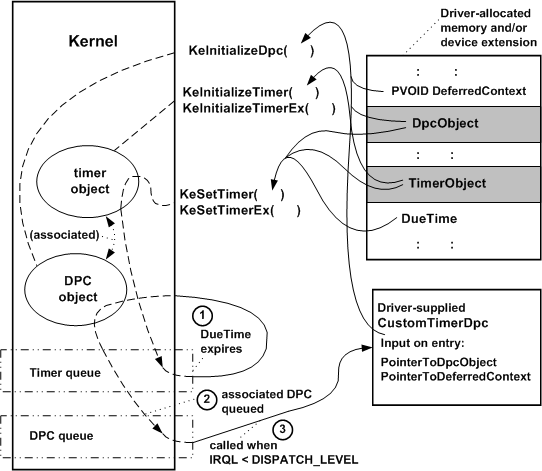Registering and Queuing a CustomTimerDpc Routine
A driver can register a CustomTimerDpc routine by calling the following routines, usually from its AddDevice routine:
KeInitializeDpc to register its routine
KeInitializeTimer or KeInitializeTimerEx to set up a timer object
Subsequently, the driver can call KeSetTimer or KeSetTimerEx to specify an expiration time and to add the timer object to the system's timer queue. When the expiration time is reached, the system dequeues the timer object and calls the CustomTimerDpc routine. The following figure illustrates these calls.

As the previous figure shows, the driver must supply storage for both a DPC object and a timer object. Most drivers provide the storage for these objects in a device extension or in other driver-allocated, resident memory.
In the call to KeSetTimer, the driver passes pointers to the Dpc and Timer objects, along with a DueTime expressed in units of 100 nanoseconds, as shown in the previous figure. A positive value for DueTime specifies an absolute expiration time (since January 1, 1601) at which the CustomTimerDpc routine should be called. A negative value for DueTime specifies a relative expiration time.
Because an absolute timer expires at a specific system time, the wait duration of an absolute timer is not affected if the system time changes before the timer expires. On the other hand, a relative timer always expires after the specified number of time units elapses, regardless of changes to the absolute system time.
To invoke a CustomTimerDpc routine repeatedly, use KeSetTimerEx to set the timer and specify a recurring interval in the Period parameter. KeSetTimerEx is just like KeSetTimer except for this additional parameter.
As shown in the previous figure, the call to KeSetTimer or KeSetTimerEx queues the timer object for a specified interval as follows:
When the DueTime expires, the timer object is dequeued and set to the Signaled state.
If every processor in the machine is currently running code at an IRQL greater than or equal to DISPATCH_LEVEL, the DPC object associated with the timer object is put in a DPC queue. Otherwise, the CustomTimerDpc routine is called.
If the DPC object was already in the queue when the DueTime interval expired, the CustomTimerDpc routine is called as soon as the IRQL on any processor in the machine falls below DISPATCH_LEVEL.
Note
The CustomTimerDpc routine, like all DPC routines, is called at IRQL = DISPATCH_LEVEL. While a DPC routine runs, all threads are prevented from running on the same processor. Driver developers should carefully design their CustomTimerDpc routines to run for as brief a time as possible.
The smallest time interval that can be specified to KeSetTimer and KeSetTimerEx is approximately ten milliseconds, so a driver can use a CustomTimerDpc routine when timing smaller intervals than an IoTimer routine, which is run once per second, can handle.
Only one instantiation of a particular timer object can be queued at any moment. Calling KeSetTimer or KeSetTimerEx again with the same Timer object pointer cancels the queued timer object and resets it.
Setting up a CustomTimerDpc routine is exactly like setting up a CustomDpc routine, with an additional step to initialize the timer object. In fact, their prototypes are identical, but CustomTimerDpc routine cannot use the two SystemArgument pointers declared in its prototype.